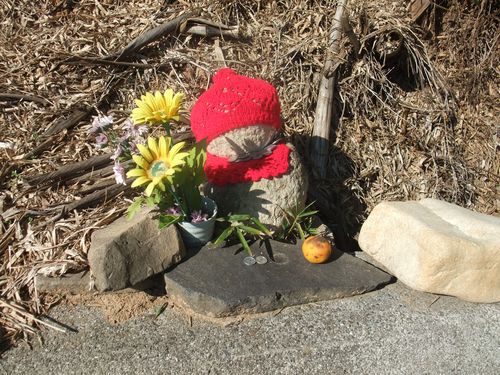The topic, Ksitigarbha is from Buddhism. It is called "ojizousama" in Japanese and is supposed to look after children, travellers and the underworld. I found an ojizousama at the roadside and I'm going to write about it. To tell the truth, I had noticed it for several months, but I thought that the topic about Buddhism was too weighty for me to write about here, however I changed my mind having found its apron and cap changed and washed. I'll try to describe Ksitigarbha, though this entry might be hard to understand.
You might have seen the statue of Buddha in Buddhist temples. I think that you could pick up the fact that two Buddhist images accompanied Buddha. The Buddhist image on the right side viewed from Buddha is Samantabhadra (Fugen Bosatsu in Japanese) and another is Manjusri Bodhisattva (Monju Bosatsu likewise). Samantabhadra is supposed to be associated with mercy and Manjusri Bodhisattva with wisdom. Thus "Fugen" and "Monju" are frequently used in Japan. As one good example, do you remember the fast breeder reactor Monju? If you have an interest, check this URL: http://www.jaea.go.jp/04/monju/EnglishSite/index.html
Being back on track, what is ojizousama for? The three symbols of Buddhism are believed to be in the sky far away from us, whereas ojizousama stays by our side and is always with us. The Bible says, "When two or more get together under the name of Christ, Christ is sure to be with them too." If you are praying alone, Christ might hear you, but he is away from you. On the other hand, in Buddhism, ojizousama is always with ordinary people. It is the most conspicuous feature of ojizousama. It is usually set at the roadside and you often see it.
Ojizousama is also said to be a guardian of children as I mentioned above. When a child passes away or is born dead, its parents often build the statue of ojizousama mourning for their child and wishing for the help of ojizousama for their child. If you find a ojizousama along the roadside, there might be the scene of a serious traffic accident where a child had been killed. If the ojizousama wears an apron and cap (usually red), it was surely built for a little kid. Some religious people wash the apron and cap and keep it clean.
The picture was shot near my house. The ojizousama was makeshift with only two stones piled up. It was set beside a vegetable field, but its apron and cap were always clean, though it was natural to be muddy. Though I have no evidence, an elderly woman might be taking care of it, recalling her child who had passed away years ago.
(Vocabulary)
Ksitigarbha 地蔵菩薩
the underworld 下層社会, 冥土, 冥途
weighty〈問題などが〉 重大な, 深刻な;weighty matters 重大な問題
pick up a fact 気づく
Buddhist image 仏
image (絵・彫刻の) 像, 肖像, 彫像 carved wooden images 木彫りの像
Samantabhadra 普賢菩薩 慈悲と理知を司る Buddhaからみて右側
Manjusri (bodhisattva) 文殊菩薩 知恵を司る仏様 Buddhaからみて左側
conspicuous 目立つ, 人目をひく;《[名]の前でのみ》 際立った, 顕著な
guardian angel(人と土地を守ってくれると信じられている)守り神
mention 言及する
be born dead / die at birth 死産する
mourn for sb <人>の死を嘆き悲しむ
but for the grace of God 神のご加護がなければ
by the help of God 神のご加護によって

Recent Comments